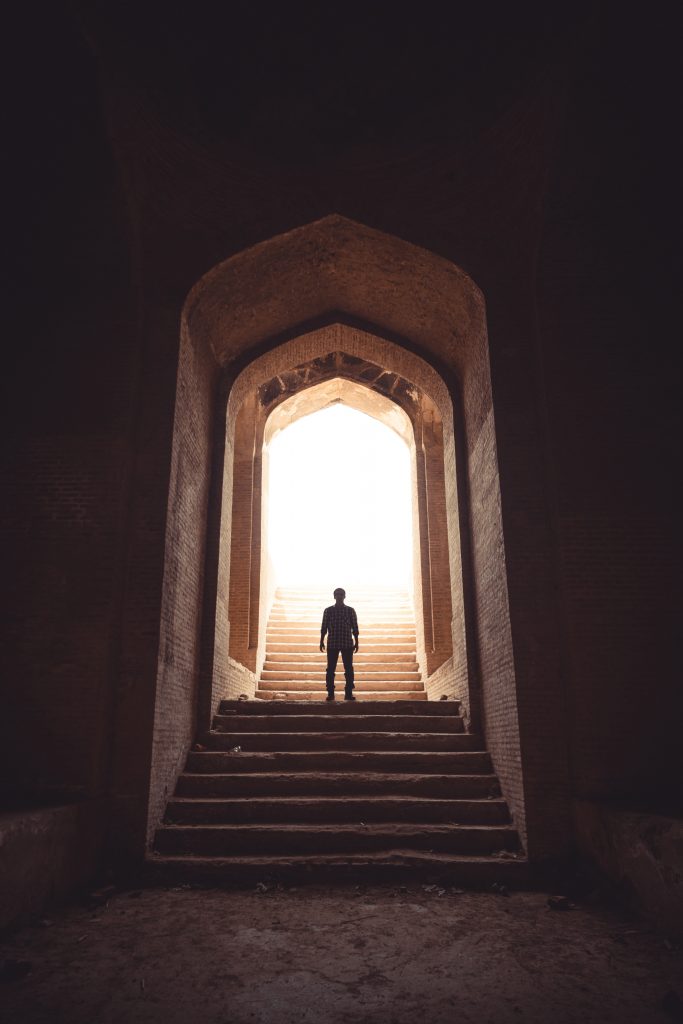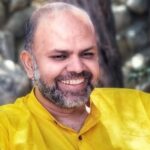
Gayatri: You seem to be very active in talking about the political situation in India like the Kashmir issue, elections, etc.
Raghu: Well, it is not something new. Of course, there are many triggers nowadays.
Gayatri: You are a yoga teacher, so how come you are taking an interest in politics?
Raghu: Why? What is wrong in taking an interest in politics? I am wondering whether that question comes up because you have internalized the perception that most people have about yoga.
Gayatri: Maybe a Yogi is a person who stands on Bhagiratasana in the HimAlayas and has renounced the world.
Raghu: It is funny because that is the “Amar Chitra Katha” version! You must remember that many of the great Rishis have not only been advisers to Kings but were also householders. It is the Buddhist idea that any person taking up the sangha must renounce the world.
Gayatri: Well a yogi should not be entering the bad world of politics no?
Raghu: So, we need to examine this. In the English language, they use the word with a capital P, when they talk about elections, political parties etc. The other is a political reality, which means a community of people, a city and so on trying to live their lives in a safe manner. Thus, every individual living in this society is part of a political reality. So, I am just baffled with the idea that a sincere yoga practitioner cannot get involved in politics.
Gayatri: I just checked the dictionary about the word politics and the synonyms that came up were manipulation, opportunism, Machiavellianism, maneuvering etc. There is nothing positive about the word.
Raghu: How interesting! But it is sad that the word has been misconstrued into this, whereas it should simply mean a group of people who come together to govern themselves.
Gayatri: Yes, that is one meaning of the word-activities associated with the governance of a country or area.
Raghu: My teacher, the great Yogacharya Sri Krishnamcharya was an advisor to the Maharaja of Mysore. One of the many areas or activities that a Yogi took part in was spying.
Gayatri: Why?
Raghu: Because they are people who have a lot of discipline, good memory etc. Sahadeva was also a spy and he was a great yogi too. So, an idea of a Yogi sitting on the hilltop in some contorted asana is not a very meaningful idea. Chanakya wrote extensively about Yoga.
Gayatri: What were his insights about yoga?
Raghu: His basic thesis was that a King ought to be a yogi so that he can be anchored in right perception and right decision-making. An ideal king ought not to be carried away by his subjectivity, his desires and aversions, his greed and so on. This is not just his idea; this is the way a Janaka is defined.
Gayatri: How does this link with my yoga practice
Raghu: So, if we come back to one’s own yoga practice, there are three critical commitments that are necessary for one to be on the path of yoga. Shri Desikachar has talked about this extensively.
- To understand human duHkha– He said if you really want to call someone a good yoga teacher, the first qualification is this person has to be very deeply concerned about human sorrow. Sankhya clearly says that it is concerned with duHkha traya. This is further elaborated as below-:
- What are the sources of duHkha– In the context of politics, a lot of human suffering comes from the way social norms are practiced and how society is governed and so on and so forth. So, to practice yoga one needs to understand these sources of suffering. Also, when I teach someone, I can offer reflections or another perspective of looking at reality so that the student can develop a meaningful view of reality.
- Regaining swantantram- One of the meanings of the word duHkha is that one has handed over his/her swantantram to someone else. Teaching Yoga is about helping the other person regain a sense of choice
- This brings us to a critical dimension of politics, how does one deal with power? So, am I capable of finding a sense of self-oriented choice-making? Which means that I am not giving into an oppressive form of power. So, within the yogic path, there is a very strong reason for us to be involved with society, to be involved with what is happening in the governance processes, in the way power is used and all of that.
- ahimsa: This means that I understand my boundaries so that neither do I transgress other people’s boundaries nor do I let others violate mine. If practiced diligently, ahimsA is an extremely important building block for a healthy society, because it respects people for who they are and helps to maintain healthy relationships. This applies not only to humans but other living beings as well. This is also called a mahA vratam and if practiced sincerely one is an exemplary citizen.
- satyam: In yoga satyam is also sometimes referred to as a mahA vratam. It means that I strive to discover the truth. I need to have a pratyaksham; I have to look at an object or an enquiry, see it, experience it directly and I cannot take what somebody else says as truth. In yoga there is the idea of Agama, the word of trustworthy wise people. Yoga says that I cannot take someone else’s word or theory as the truth, it can only be a starting point for the search. An engagement with yoga sAdhana means making sure that I can perceive truth; work with myself so that I create a psyche capable of looking at truth. Societies today respect the works of science and their quest to discovering the truth. Yoga agrees with this totally but adds the inner dimensions to the enquiry. This aspect is very important for any polity to continuously grow and evolve.
If I base my yogic practice on the above three pegs, I can be a splendid citizen. This also means that I will stand firm if my boundaries are threatened but I will not aggress upon another. Whether the land is governed through a democratic process or not is not the key. Which is why the old Tamil statement “how does your adherence to dharma get affected by whether Rama is the ruler or Ravana?” I will take responsibility and I am not going to allow oppression to happen, to me first of all. And then if I extend it, I will always be on the side of action where oppression is not possible. So, as we are conversing about this question, it seems to me that being a true yogi is a great way of being politically alive today. Thank God Guru Shri Tegh Bahadur, Swami Shraddanada and Swami Vivekananda were politically alive!
Gayatri: This sounds more like a self-governance process rather than the Politics of governance. If each of us practiced the above three principles, then we would not need to look at the government to provide safety, security, justice etc. So, where is the disconnect?
Raghu: I was talking to a dear friend who is a very involved political activist and when I was explaining my hypothesis to him, he also said that the process I am speaking about is self-governance and it is the building block of any good governance.
As we were discussing these ideas it came out that the difference in thinking is arising out of a few notions about Governance. Let us look at the idea of rights and entitlements that we have embodied in the constitution. But yoga talks about responsibilities first and rights are an offshoot of it. For example, if I elect somebody into a position of governance and if that person takes these three yogic principles seriously- that person will try and govern as fairly and as equitably as possible without causing duHkha to anybody, without creating himsAtmik contexts without spreading false news etc. So, the responsibility of the government will be primary, and the entire political discourse will be a discourse of responsibilities and not of rights.
In a country like India where we have gained our independence to govern ourselves through fighting a colonial authoritarian regime, the rights issue becomes very prominent; because that is the way, we gained our independence. But it is important to understand the discourse by way of responsibilities rather than rights. Actually, depending upon a governance process to ensure one’s rights is a loss of swantantram and you are placing the choice making in someone else’s hands, which is the elected government. Colonial rulers were always interested in exploiting the country’s resources and the idea of rights comes from the misuse of resources and our resistance to that process. Rights enshrined in law is important but one’s behavior cannot be determined by it.
Gayatri: So, how was governance in India prior to the British?
Raghu: It was based on the idea of self-governance only. Dharampal ji has written extensively and others have also published a lot of research on the pre-colonial times. The local Kings were sensitive to the subject’s views especially in terms of discharging one’s responsibility as the King. Dharampal ji writes about a protest recorded in Varanasi when the townsfolk stopped doing their work, walked out of town and started to make a noise by banging their vessels to reiterate that the King has not fulfilled his responsibilities.
Hariprasad: You have done a lot of grassroots level work with communities and tribes no?
Raghu: Yes, in fact, the koodam which was the way communities used to function has been revived by me and my colleagues in the Barefoot Academy of Governance. When people used to come together in a koodam, they dropped their status and power equations to ask what is the dharmic thing to do? Now, the moment you asked the question what is a dharmic thing to do among a group of people, you are talking about the politics of responsibility. How can all of us be responsible to each other? So, discuss and decide on how we bring in the greatest good for people. We have had Dalits and upper-class landowners come together to discuss a variety of issues and act in a responsible way. As a yoga practitioner, I have involved myself in designing these programs and running them. So, I am relieving people of their duHkha by doing this.
Gayatri: What does yoga say about power struggle and authoritarianism?
Raghu: swatantrata. If I am a Yogi, I have to respect swatantrata, because if I take away somebody else’s swatantrata; I am doing himsA on that person, thus, creating duHkha in that person. So, wherever I am, if I am in a position of power then whatever is under my jurisdiction has to be a space, which does not create himsA and duHkha. If I am a yogi, those will be my most important measures of action. So, this is what Chanakya also talks about in his treatise on Yoga: how the person discovers within himself the ability to be above subjectivity, and then actually govern in ways that are fair and firm.
Gayatri: I am also seeing a lot of need for dialogues and spaces to examine these concepts of fairness and equity.
Raghu: If I am concerned with truth and if I take some of the Indian ideas seriously, I cannot shout saying I know the truth. I can only say, I have come here and would like to discover the truth. And, if I respect you and if I respect ahimsa, I have to ask you how do you understand truth. And, then both of us need to dialogue as equals to discover what is the truth so that the two of us can commit to it as our best effort at this point of time; this is the essence of dialogue. So, automatically the most important process in the political context will be a dialogue in search of the truth.
Gayatri: When did you first discover or re-discover the koodam model of governance?
Raghu: My colleagues and I had to do projects for government departments like the Tamil Nadu education department, water department etc. We were faced with the question of how do we deal with these people who are generally corrupt? and how do we get them to work for the social good? In some villages and families, the koodam is still practiced. I have seen it in action. After researching about it, we decided that this Indian form can work and needs to be evoked in people. We conducted the Koodam in the Education department to start with. The space had all the stakeholders of the action from the higher officers down to the executives on the ground. After some initial inputs and dialogue, we confronted them with the question ‘What is the dharmic thing to do?’ IAS officers were willing to give up their power after confronting this question, some wanted to utilize their power judiciously and have dialogues with people to act dharmically. The spirit of the koodam was very much alive in their minds, and they spoke up once we introduced this idea. They spoke about the fact that this was the way things would happen in their families. We just infused it with some elements to make it relevant for the current context.
Hariprasad: If I look at politics happening in yoga: nowadays people are taking credit and innovating and creating practices like Christian yoga etc. How do we look at these aspects?
Raghu: If a person practices yoga, this would be seen as cultural subversion and a violation of aparigraHa. How can you take a whole system, pull out only what you want, put it into a different context, give it a completely different spin and still say this is ok?
To me, the idea of Christian yoga is an oxymoron because the fundamental idea of Christianity is to look at an external God and obedience to his word. Whereas, yoga talks about discovering the truth within oneself.
Hariprasad: I am reminded of an incident narrated to me by my fellow yoga teacher who is a Christian and she was teaching a group class in Thailand. She ended the class with three OM’s and one of the students shouted ‘Hail Jesus’ instead. After the class, the student was very disturbed and scolded the teacher for saying OM despite being a Christian.
Raghu: OM and Hail Jesus do not come from the same universe. OM is a sound or a vibration to touch something deeper within you not to hail someone outside. This is the politics of colonization where you want to go and appropriate cultural symbols, you want to take something that is very useful and meaningful in somebody else’s universe. But you do not want to respect the whole context in which that is placed. Buddhism is also facing similar issues. In a Buddhist practices ahimsA, satyam and duHkha nivarana are very critical. These three concepts are I think extremely essential for a human pursuit of growth and self-development. Whereas, if you take meditation, call it mindfulness and take these aspects out and place the practice in some other context, then you are using a utilitarian process to deal with a reality which is founded in spiritual search and not utilitarian principles. Yoga is meant to alleviate human suffering, unfortunately, some of its anga can be used as ends in themselves.
Hariprasad: But I see many teachers scared to teach chanting like OM and thus, they want to take the utilitarian aspects of yoga only.
Raghu: In Yoga, one is not stopped from praying to one’s ishTa devatA even if it is Mary otherwise, that also becomes a form of oppression. Now what these teachers face in their countries or religions is their issue and we cannot police them. All I am saying is that valuing the three pillars mentioned earlier is a strong enough political statement. Cultural appropriation is a violation of ahimsa and satyam.
Hariprasad: A while ago, I did a workshop with a group of youngsters from Kashmir, before the practices of yoga began, they saw the whole Kashmir situation as communal politics etc. Once they started looking at their own locations from the space of shAntam, ahimsa and satyam, they were ready to dialogue.
Raghu: Yes, such spaces are a must. But I am also seeing the need for a yogic practice, as a way to practice good politics. Yoga actually talks about the independence of the person, respecting the agency of the person and so on. So, whatever democratic ideals people are talking about is automatically built in these practices.
Gayatri: Can I say this about any religious practice?
Raghu: The moment my truth is better or more important than yours it can never be a democratic practice; the fundamental principle of yoga has been violated. Yoga does not ask you to do that.
Gayatri: What were Krishnamacharya’s insights when he was an advisor to the Maharaja of Mysore?
Raghu: Well, he would give his advice towards what he thought would be the right thing to do when the Maharaja invited him to share his ideas. Of course, he would share it with forthrightness, clarity, and honesty.
Hariprasad: What about the politics that affected Yoga in India? For e.g. Krishnamacharya had to move to Chennai after Mysore.
Raghu: Krishnamacharya’s moving from Mysore to Chennai was political in the sense that when the Congress government took over, the new government took an antagonistic stand against the people who supported the monarchy. The whole household of the Maharaja was disbanded and Krishnamacharya chose to move to Chennai.
What was at stake at that time was the patronage of people in power was lost for people in traditional occupations. This is different from the idea and formation of the human collectives; how power is used in human collectives and how a practice of yoga has a relationship with this whole universe of power. Running behind patronage does not seem to me to be a very nice aspect of being a Yogi. Shri Krishnamacharya never did that.
Gayatri: You have talked extensively about the victim, oppressor and savior model. Can we look at that in the context of politics?
Raghu: Let me give you an example of Guru Tegh Bahadur and Aurangzeb. The Guru was a yogi, he went to the aid of Kashmiri Pundits and challenged Aurangazeb to convert him. He simply said that I will not bow down to any pressure of yours and I will not accept anything that is not true. He paid a price, was tortured and was killed.
So, the moment I practice yoga I am completely out of this oppressor, oppressed, savior dynamics. Because I am starting with the premise that I have swatantrata and I can make my choices. And there are three anchors to decide how I use my power, swatantrata is where I use my choice making power to reduce duHkha, second is ahimsa and third is satyam.
Gayatri: It is mutuality of respect, right?
Raghu: Yes. Now if you are suffering psychologically, I can only enable you to discover your swatantrata, through which you overcome your duHkha. Thus, I cannot make you dependent on me. At that level of human interaction, equity has to be practiced, and equity is the ground and the basis for democracy.
Sahiti: Aren’t koodams about taking up issues too?
Raghu: No, koodams do not make a protest or noise. For example, one of the village issue we took up was water. You are taking up an issue that is causing duHkha to a whole cross-section of society. In this particular case, we were looking at water. So, how do you then get the whole of society to work with each other in a way that is respectful and that takes on the responsibility for providing everybody with water in equitable ways? The causes are not individual or selfish.
Sahiti: Isn’t it hard to follow this, to understand the collective truth, state it, etc.?
Raghu: Yes, it is, when I talk about the three pillars of yoga, I do not mean one must stand on one leg in the Himalayas or start a movement by giving speeches. Start working with yourself first; it will spill over in your relationships and interactions with others too. These three pillars are powerful political statements.
Gayatri: Isn’t there a fear of elimination like what happed to Guru Tegh Bahadur?
Raghu: Yes, it is possible. But there is also the example of Swami Vivekananda in his famous speech at the Parliament of World Religions, where he spoke about the openness of Hinduism. A place where each of the speakers was talking about the greatness of their own religion, he shifted the foundations of any divisive thoughts that may occur in men. It was a very powerful political statement and many people welcomed it.
Sahiti: I am also interested to understand swantantra in the context of my space and the other’s space.
Raghu: I remember an incident where a person with a mental disturbance had visited Krishnamacharya Yoga Mandiram (KYM) and Shri Desikachar dealt with it in an interesting manner. When that person came and asked a few questions; Desikachar simply said “you do not worry, I am here for you. Anytime you need my help and you make a choice to call me, I will be right there with you.” Now, immediately that person felt extremely safe and his body posture changed. Later Sir told us that it is very important for the person to know that he/she is in charge of making a choice. In this case, the person was perhaps pushed into coming to KYM but Sir, made him feel that it was his choice.
Sahiti: So simple yet beautiful
Raghu: The next step is to help them improve their state of mind, help them make meaning about the world and thus, make better choices. Therefore, it cannot be that ‘the teacher is responsible for making the choice for you now.’
Sahiti: I see it as a very important ability to cultivate especially in young kids and adults.
Raghu: Choice making today is getting lost because of group conformity and it is another kind of oppression. There have been so many disconnects within us due to colonization, religious oppression and so on. All we want people to experience through yoga is to get in touch with themselves at all levels- body, breath, and mind. Re-connecting with one’s body and not looking at it from other people’s judgments is a way to swantantram also. Our lack of connectedness to nature or the space around us is a loss of freedom. The colonization is based on the concept of superiority over other people, over nature and thus, so much of himsA takes place when one acts from this mindset. As a Yogi, I must address all these aspects for myself. So, if this is termed as a political statement, so be it.
Sahiti: But there may be different ways to get there?
Raghu: All I am saying is that if I sincerely accept the practice of yoga, I am moving the world towards an equitable democratic space. Thus, anything I critique from this mind will automatically move it in this direction.

 Anoop is a student of Yoga, an entrepreneur, a coach and a father of two young boys. He has led successful leadership stints in both the corporate and non-for-profit sectors. On encountering the country’s water/farmer crises at close quarters, he decided to pause and examine the impact various ‘isms’ – capitalism, colonialism, etc., were having on us as individuals, families, the society and the environment at large. This quest led him to formally engage with traditional Indic knowledge systems while also learning from the latest advances in science – about our physical and mental wellbeing, importance of body and mind work in healing trauma and the urgent need for a conscious rebuilding of family / work / social structures if we have to thrive individually and collectively. Insights, frameworks and processes gleaned from these on-going studies, an anchorage in his own personal practice and his wide-ranging experiences is what Anoop brings to facilitation/coaching spaces in Ritambhara and his various professional engagements.
Anoop is a student of Yoga, an entrepreneur, a coach and a father of two young boys. He has led successful leadership stints in both the corporate and non-for-profit sectors. On encountering the country’s water/farmer crises at close quarters, he decided to pause and examine the impact various ‘isms’ – capitalism, colonialism, etc., were having on us as individuals, families, the society and the environment at large. This quest led him to formally engage with traditional Indic knowledge systems while also learning from the latest advances in science – about our physical and mental wellbeing, importance of body and mind work in healing trauma and the urgent need for a conscious rebuilding of family / work / social structures if we have to thrive individually and collectively. Insights, frameworks and processes gleaned from these on-going studies, an anchorage in his own personal practice and his wide-ranging experiences is what Anoop brings to facilitation/coaching spaces in Ritambhara and his various professional engagements.
 Priya is a Yoga therapist in the Krishnamacharya tradition. She adapts Reiki & energy work, Vedic chanting, life coaching & Ayurvedic practices in her healing spaces. She is committed to nurturing collectives that have the praxis of Yoga at their heart.
Priya is a Yoga therapist in the Krishnamacharya tradition. She adapts Reiki & energy work, Vedic chanting, life coaching & Ayurvedic practices in her healing spaces. She is committed to nurturing collectives that have the praxis of Yoga at their heart. Anisha has been on an exploration to understand herself through yoga for the last 15years which led her to teaching yoga, yoga therapy and inner work through yoga.
Anisha has been on an exploration to understand herself through yoga for the last 15years which led her to teaching yoga, yoga therapy and inner work through yoga. Apoorva chanced upon Yoga in her early 20s. A spark was lit within and there was no turning back. Her exploration led her to the Krishnamacharya tradition more than a decade ago. Curious about human behaviour and what drives it, she was thrilled when her search ended (and also began) when she first came upon the Yoga Sutra, which illuminated a path towards answering many questions that had been held for a long time.
Apoorva chanced upon Yoga in her early 20s. A spark was lit within and there was no turning back. Her exploration led her to the Krishnamacharya tradition more than a decade ago. Curious about human behaviour and what drives it, she was thrilled when her search ended (and also began) when she first came upon the Yoga Sutra, which illuminated a path towards answering many questions that had been held for a long time. Anita is a yoga teacher and therapist in the tradition of Sri.T.Krishnamacarya and Sri T.K.V. Desikachar, a Reiki practitioner and a Life Coach. She is also the founder of Vishoka, a center for learning Indic and energy-based frameworks for living and healing. Her deep concern for human suffering and the problems of unsustainable living kept her on the path of seeking an integrated approach to looking at life, living, learning and healing.
Anita is a yoga teacher and therapist in the tradition of Sri.T.Krishnamacarya and Sri T.K.V. Desikachar, a Reiki practitioner and a Life Coach. She is also the founder of Vishoka, a center for learning Indic and energy-based frameworks for living and healing. Her deep concern for human suffering and the problems of unsustainable living kept her on the path of seeking an integrated approach to looking at life, living, learning and healing. Ankit is a seeker in the wisdom traditions of India. The core of his work includes creating dialogic spaces where people can look within and see the connection between their inner and outer lives. Inspired by the likes of Gandhi, Aurobindo, Vivekananda and Guru Gobind his experiments in service took him back to his roots in Punjab where he is creating a community-led model of higher education which is open, inclusive and accessible for all. Ritambhara for him is a space for engaging in a community which is committed to a DHramic life. He anchors his work of learning and leadership in the Antaranga Yoga Sadhana and the humanistic wisdom of Mahabharata.
Ankit is a seeker in the wisdom traditions of India. The core of his work includes creating dialogic spaces where people can look within and see the connection between their inner and outer lives. Inspired by the likes of Gandhi, Aurobindo, Vivekananda and Guru Gobind his experiments in service took him back to his roots in Punjab where he is creating a community-led model of higher education which is open, inclusive and accessible for all. Ritambhara for him is a space for engaging in a community which is committed to a DHramic life. He anchors his work of learning and leadership in the Antaranga Yoga Sadhana and the humanistic wisdom of Mahabharata.